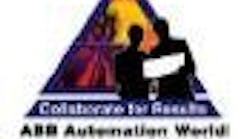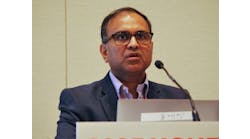ABB R&D Director Sean Keeping said, "We're going to wait another 30 seconds," as we were waiting for him to begin to talk about ABB's advances in instrumentation. Then, as if on cue, the room doors blew open and ABB instrumentation vice president of marketing Bob Hausler appeared. His timing was superb. The session dissolved in laughter.
The reason I went to the session was because of its subtitle: Why It Matters. Keeping and Hausler tried very hard to talk tech and keep bringing it on back home to why end users should care.
Keeping gave the obligatory overview, with a chart that showed the hierarchy of Sensors->Hardware and Software->process and condition data->communications backbone->visualization/HMI->enterprise.
One of the things ABB is proud of is their rationalization of device HMI to a simple and consistent interface that Hausler called "The ABB Universal HMI Interface" but which is likely to be called something else because that's hard to say. As they started last year with the 364 pressure transmitter and the new video recorder, the interface is modeled deliberately after the common four-button cellphone interface that just about everybody can use and more or less understands.
When it comes to digital bus infrastructure, Keeping was emphatic: ABB is bus agnostic. "We would like there to be only one fieldbus standard, but as long as there are many, we'll support as many of them as our customers want us to. We at ABB want to minimize the proliferation of standards."
When it comes to the unending controversy over EDDL versus FDT/DTM, Keeping was even more forthright. "Some people," he said, "have suggested that ABB favors one or the other. That could not be further from the truth. We at ABB believe that EDDL and FDT/DTM are complimentary and not competitive. We support both, and both have their uses in our equipment and systems. We don't see one dying and the other winning."
Keeping talked about the new standalone asset management system ABB is introducing, called AssetMaster. "Our dream," he said, "was to produce a scaleable approach, built on 800xA technology that will handle setup and commissioning, database management, condition monitoring, calibration, asset management, and incorporate wireless technologies.
And on the subject of wireless, Keeping noted, as Peter Terwiesch had earlier in the day, that ABB has a long history of wireless.
Wayne Manges, the chair of SP100 was in the room, and after the session, Manges, Keeping, Gareth Johnston (who is the ABB HART Wireless champion), myself and J. D. Lobo, ABB R&D manager for instrumentation had a quick ad-hoc meeting concerning how to get ABB's participation in SP100 to be ramped up. ABB's participation in the HART Wireless Working Group has been a significant stabilizing influence on that body, and it would be nice if they would perform the same service for SP100. I believe you all will see ABB more involved in SP100.
Keeping noted that we do not need another fieldbus debacle. The industry doesn't need it, the end users don't want it, and, even more importantly to him, ABB doesn't want to continue supporting a card deck full of standards indefinitely. It is too expensive. God, it's nice to preach to the choir.
Manges even suggested something that I think is very very smart. He asked Keeping if ABB would consider bringing their discrete manufacturing cell wireless technology, which includes "power over wireless" to SP100 to become part of the standard. Keeping was noncommittal, but that surely was a great idea Wayne had. I hope it comes to pass.
Just after, I sat in on Wayne's Cyber Security session, which was an ISA presentation that pretty well captures the state of the art in cybersecurity. Several end users left the session with their eyes open, thinking about interesting challenges they hadn't realized were there.

Leaders relevant to this article:





